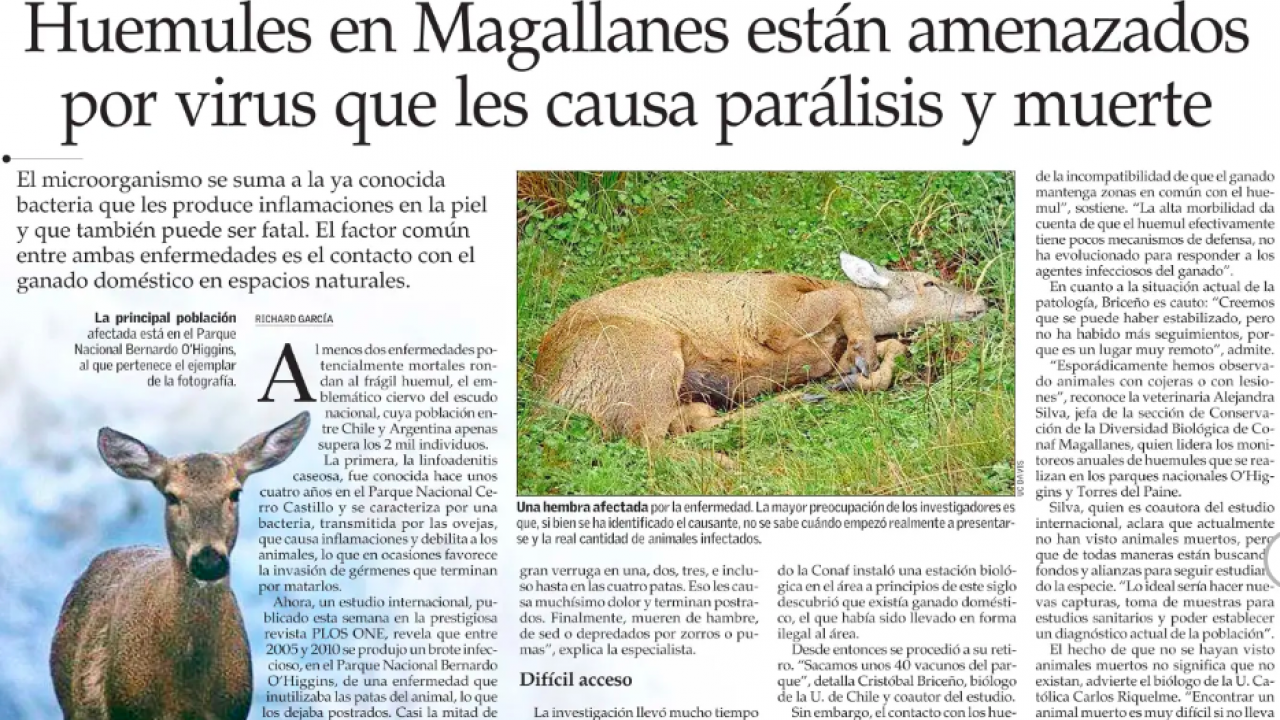
Huemuls in Magallanes are threatened by a virus that causes paralysis and death
Summary of the article written by Richard García, of "Life, Science and Technology", El Mercurio newspaper
An international study was carried out between 2005 and 2010 on an outbreak of viruses causing paralysis and death to huemuls (Hippocamelus bisculus) in the Magallanes region (South of Chile), in addition to an already known bacteria producing inflammation and sometimes death. In both cases huemuls had been in contact with domestic livestock in natural areas.
The huemul, the emblematic deer on the Chilean coat of arms, with a population between Chile and Argentina of only around 2,000 is being threatened by two fatal viruses.
The first, the Caseosa lymphadenitis, discovered in the area of Cerro Castillo, Aysen (South of Chile), is a bacteria transmitted by sheep, causing inflammation which debilitates the animals´ immune system and finally kills them.
While PLOS ONE magazine just published an article about a second disease, a bacteria that affects the huemuls’ legs. The study focus on an infectious outbreak between 2005 and 2010 in the Bernardo O'Higgins National Park (South of Chile) which starts with a large and painful wart, disabling the huemuls’ legs and leaving them prostrate, consequently dying of hunger or thirst or falling prey to foxes or puma. In fact, half of the 24 infected animals died. The Argentine veterinarian Marcela Uhart, Director of the Latin American Program of One Health Institute of UC Davis, led the study which also included specialists of the Wildlife Conservation Society (WCS), the University of Chile and the Chilean National Forestry Corporation (CONAF).
Difficult access
The research was quite painstaking, due to few and poor samples, as the largest huemul population inhabit the area of the Bernardo O'Higgins Park, a remote and rugged terrain on the border of Chile and Argentina. Uhart explained that in order to achieve a result, they had to resort to some very sophisticated techniques in the USA. The conclusion was that the disease is related to smallpox and is transmitted by domestic livestock.
In 2002 when Conaf built a biological station in that area, domestic cattle which had been brought illegally into the area were found.
Since then about 40 cattle have been withdrawn from the park, explained Cristobal Briceño, a biologist at the University of Chile and co-author of the study, but the consequence of their contact with the huemul has been a high death rate of the same.
Briceño is concerned that the conservation of the species would be affected and like Uhart, found that the analysis was complex and they had study it several times in order to arrive at a convincing conclusion.
Both in lymphadenitis and in this case, there is a common factor: contact with livestock in natural areas, warned the veterinarian.
In this and in the case of lymphadenitis, huemuls have been in contact with livestock in the wild. Cristián Saucedo, Conservation Director of Tompkins Conservation concluded that cattle should not be kept in areas inhabited by the huemul which have not developed antibodies capable of fighting infections from livestock.
Since the areas inhabited by the huemul is so remote, making monitoring difficult, it is not possible to conclude that the disease has been stabilized, he admits.
Alejandra Silva, Head of the Conservation of Biological Diversity section of CONAF at the Magallanes Region and co-author of the international study, monitors huemuls annually in the O'Higgins and Torres del Paine National Parks. She declared that lame or injured, but not dead huemuls have been sighted.
She explained that they are looking for funds and alliances to continue studying the species, take new samples and make a new diagnosis of the current health of the huemul population.
Catholic University biologist Carlos Riquelme explained that it is difficult to find a dead animal if it does not wear a radio collar. In a recent trip, he saw between one and three huemul who had hoof problems, but could not conclude that this was an important number, since they do not have clear data of the total population.
He does, however, acknowledge that there is a link between climate change and the incidence of this kind of disease.
To read the web version of the entire article (in Spanish), click here